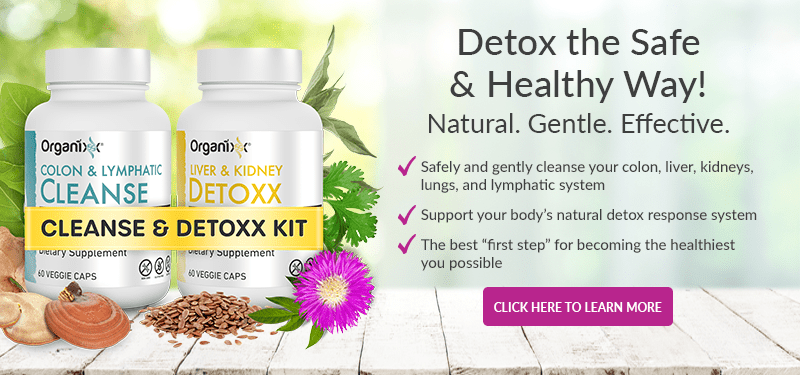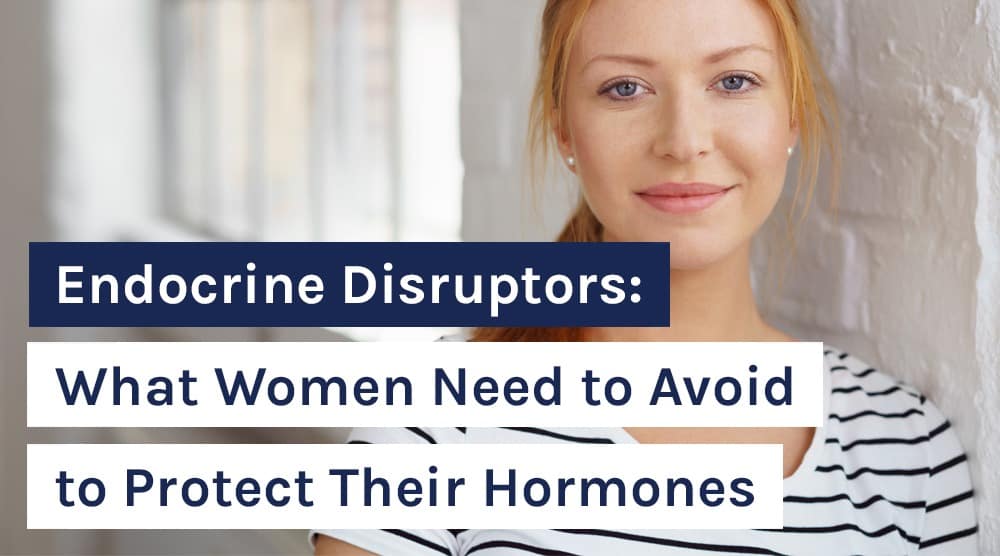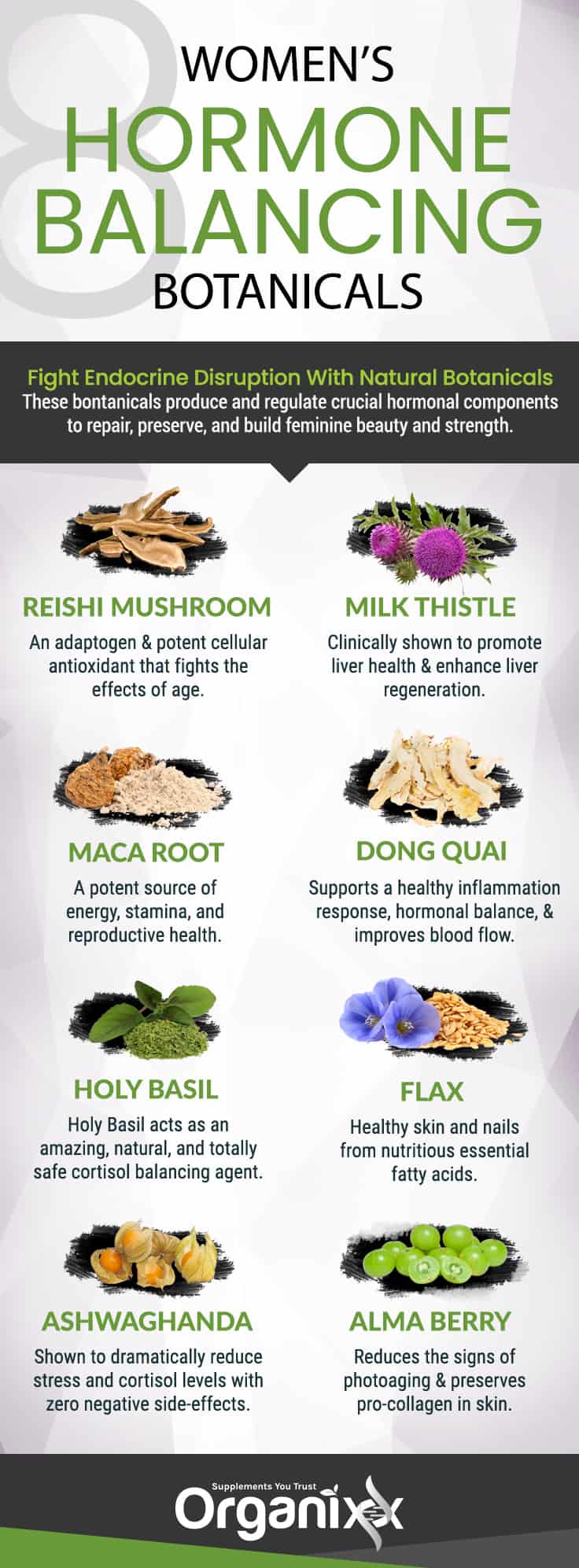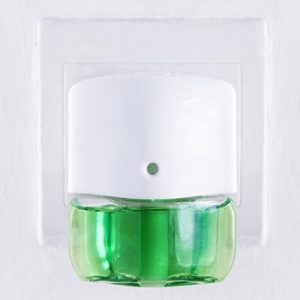Endocrine Disruptors: What Women Need to Avoid to Protect Their Hormones
In a hurry? Click here to read the Article Summary...
From the moment of conception all the way into adulthood and beyond, there exists an unseen force inside you that keeps you alive, healthy, and vibrant: hormones. These tiny chemical messengers comprise what’s known as the endocrine system and control virtually every system of the body – from mood to muscle development to food metabolism to reproduction and everything in between.
Hormones are what facilitate the constant knitting together and sustaining of human life both inside the womb and out. They spend all of their time traveling to and from organs and tissues via the bloodstream, performing important maintenance tasks and other necessary duties [1]. Without hormones, human life would cease to exist. This is why it’s vitally important to maintain healthy dietary and lifestyle habits to help support the proper balance of your hormones and to avoid harmful endocrine disruptors.
The Correct Hormone Balance for Women vs. Men
If you’re a woman, this means aiming to achieve a homeostatic balance that favors a higher level of estrogens compared to androgens (male sex hormones). The opposite ratio needs to happen in men, however, with men needing more androgens, such as testosterone, and less estrogen. The key word here is balance, though, as too much or too little estrogen in relation to testosterone can wreak tremendous havoc on a woman’s body. (An imbalance of testosterone respective to estrogen can do the same thing to a man’s body).
It’s a delicate and complex nudging process that, thankfully, the human body is designed to handle all on its own. At the same time, there are a number of endocrine disruptors that can throw this hormone production autopilot effect completely out of whack.
Factors such as poor diet, stress, and exposure to toxins represent a few of the more prominent examples of endocrine disruptors. When this scenario occurs, grabbing hold of the hormone wheel and taking over may be necessary to help steer your hormones back on course.
Signs & Symptoms of Hormone Imbalance
It all starts with identifying a hormone imbalance, which can paradoxically be both simple and challenging. Simple in the fact that the symptoms of hormone imbalance are common, but challenging in that many of these symptoms are shared by a host of other health conditions.
The hormone-related abnormalities that many women experience, in other words, may point to a number of other health conditions. This is why it’s advisable that any woman who believes that she might be suffering from a hormone imbalance undergo proper blood work under the guidance of a qualified healthcare practitioner.
Some of the symptoms a woman can look out for that may point to a deficiency of estrogen, progesterone, cortisol, thyroid function, or testosterone (yes, even women can be deficient in testosterone) include the following, many of which cross over into the other categories [2]:
Signs of Estrogen Deficiency

- Hot flashes/night sweats
- Problems sleeping
- Persistent headaches
- Problems focusing and retaining memories
- Heart palpitations
- Dry skin
- Depression
- Low libido/painful intercourse
- Osteoporosis/bone loss
- Yeast infections
Signs of Progesterone Deficiency
- Weight gain
- Swollen breasts
- Anxiety
- Irregular menstrual cycles
- Cramping
- Acne
- PMS (postmenopausal symptoms)
- Depression
- Mood swings
- Joint pain
- Acne
- Infertility
Signs of Cortisol Deficiency
- Craving for sweets
- Allergies
Signs of Low Thyroid Functionality
- Constipation
- Low body temperature/intolerance to cold
- Cold extremities
- Low blood pressure
- High cholesterol
- Brittle nails
Testosterone Deficiency
- Muscle weakness
- Incontinence
- Fibromyalgia
- Irritability
- Lack of motivation
- Thinning skin
- Vaginal dryness
- Male-pattern hair growth
- Insomnia
- Loss of hair on scalp
- General aches and pains
- Chronic fatigue
It may seem strange, but many of these same symptoms are also associated with having an excess of estrogen hormones, or with having an overactive thyroid.
Once again, it’s all about balance when it comes to hormones and how they affect the body. But it’s also important to remember that fixing an imbalance isn’t necessarily as simple as just popping a pill to raise one hormone or decrease another. Doing this can actually make the problem worse, especially when it fails to account for why the imbalance is occurring in the first place.
The 3 Big Causes of Endocrine Disruption in Women
There are three primary categories that lend to endocrine disruption, of which women need to be aware:
- diet
- lifestyle
- environment
What a woman eats directly affects how her body produces and expresses hormones, as does the way she lives her daily life. The environment in which a woman lives – and especially the types of toxins she’s exposed to on a daily basis – is another major contributing factor to endocrine disruption.
 #1: Diet
#1: Diet
Let’s cut to the chase: the average modern diet is an absolute nightmare for women’s hormones. All that sugar and all those cheap carbohydrates really do a number on blood sugar levels, ramping up the production of insulin and consequently altering the way estrogen is metabolized throughout a woman’s body.
High-glycemic foods might as well be called high-stress foods, because the body tends to respond in kind by producing more cortisol, aka the stress hormone. This results in a systemic inflammatory response that further damages bodily systems, and the rest goes progressively downhill from there.
When women avoid sweets and refined grains and instead stick with low-glycemic, higher-protein foods, such as bone broths, grass-fed meats, and organic vegetables, they help their bodies to better support a healthy inflammatory response.
This also aids the body in producing the right amounts and types of hormones for systemic balance in all the right areas.
Further steps include avoiding alcohol, which actively decreases human growth hormone (HGH), and consuming foods that are naturally high in magnesium (e.g., organic dark chocolate).
And don’t forget to always stay hydrated, sticking with properly filtered or spring water whenever possible.
#2: Lifestyle
Speaking of stress hormones, paying close attention to work-life balance will do wonders in helping a woman to maintain a healthy hormone profile. Stress is one of the most damaging factors that contributes to endocrine dysfunction, and it can arise from many different things [4].
Overworking yourself or getting bogged down with anxiety over the everyday affairs of life can contribute to an unhealthy stress response that leads to the body feeling the need to compensate by producing more cortisol.
This excess cortisol production can place an enormous strain on a woman’s adrenal glands, which can result in this important gland becoming fatigued and unable to produce other needed hormones. Prolonged stress that isn’t mitigated through proper rest, relaxation, and prayer, meditation, or other calming activities that give the body and mind a break is a recipe for hormone disaster.
#3: Environment
 In the beginning, the earth was perfect and free of chemical toxins that interfere with human biology.
In the beginning, the earth was perfect and free of chemical toxins that interfere with human biology.
But today, humanity faces a barrage of endocrine-disrupting chemicals (EDCs) that target virtually every glandular system responsible for producing hormones. These include the pituitary, pineal, thyroid, thymus, and adrenal glands, as well as the pancreas, testes (in men), and ovaries (in women) [5].
Limit Your Exposure to These 8 Endocrine Disruptors (EDCs)
EDCs can both supplant and mimic natural hormones, obstructing the way the body responds to and uses the real thing. EDCs are essentially hormone impostors that confuse the body into either producing too little or too many of its own natural hormones. This results in all kinds of systemic damage, much of which starts out small and worsens over time [6].
While it’s certain to be an endless battle trying to avoid EDCs entirely, there are ways to help minimize exposure, so long as a woman knows what to look for and what to avoid. Start with minimizing your contact with these 8 categories of endocrine disruptors to the best of your ability [7]:
-
Non-organic produce laden with pesticides
Atrazine, organophosphates, and other “feminizing” crop chemicals are prolific in non-organic fruits and vegetables. They’re almost impossible to avoid, in fact, which is why it’s important to stick with organic or certified chemical-free varieties whenever possible.
And don’t be confused by the term “feminizing.” These chemicals harm women just as much as they harm men, directly interfering with both sexes’ ability to maintain optimal hormone balance.
-
Plastic bottles and other consumer products made from petrochemicals
Whether it’s the plasticizing chemical bisphenol-A (BPA) or phthalates like di(2-Ethylhexyl) phthalate (DEHP), many plastic-based products are loaded with EDCs.
So are various other common consumer products like food cans, personal care products that contain “fragrance” chemicals, plastic wrap, and even thermal paper receipts at the grocery store.
-
Unfiltered water
This is an important one because all sorts of chemicals and drug residues are now being found in municipal water supplies, many of which aren’t being properly filtered out using standard methods at the treatment plant. Such chemicals include perchlorate, a byproduct of rocket fuel that displaces iodine in the body and can cause thyroid problems.
Another harmful chemical found in most municipal water supplies, at least in North America, is fluoride, which is very difficult to remove except with activated alumina, deionization, or reverse osmosis water filtration systems [8].
-
Furniture, carpeting, non-stick cookware, and other household products
Many household products that people spend a lot of time either lying on or cooking in – things such as couches, carpeting, and cookware – are often hotbeds of EDCs.
In furniture, the threat usually comes from fire-retardant chemicals like polybrominated biphenyl ethers (PBDEs). In cookware, it’s often perfluorinated chemicals (PFCs) that pose the greatest risk.
-
Air fresheners, candles, hand soaps, laundry detergents, tampons, and diapers
 Many scented household products are plagued by undefined “fragrance” chemicals that existing law allows to be used as a blanket term to define more than 3,000 individual chemicals, many of which are known EDCs.
Many scented household products are plagued by undefined “fragrance” chemicals that existing law allows to be used as a blanket term to define more than 3,000 individual chemicals, many of which are known EDCs.Hand soaps are also problematic, as many contain a hormone-altering antibacterial chemical known as triclosan that studies have shown accumulates inside the body and interferes with hormone production [9].
Then, there are laundry detergents, many of which contain highly toxic chemical byproducts known as dioxins that possess their own hormone-disrupting properties [10]. Dioxins are also being found in tampons, as well as disposable baby diapers [11].
The latter is exceptionally concerning because tiny humans are most prone to suffering severe health consequences from having their hormones disrupted during early-childhood development.
-
Phytoestrogens in food
Perhaps the worst phytoestrogenic food that millions of people eat daily (whether they realize it or not) is soy. Besides often being genetically modified (GMO) and doused in toxic herbicides like glyphosate, soy and its many derivatives are highly estrogenic, containing phytoestrogens like genistein and daidzein that can mimic natural estrogen in the body and lead to hormone disruption [12].
-
Old paint and children’s toys
Especially in older homes, wall paint is a common source of lead, a known neurotoxin that can directly interfere with normal hormone production. Old children’s toys are similarly problematic, though instead of lead they often contain arsenic, another hormone-disrupting compound [13].
-
Synthetic hormones
Many women going through menopause are told by their doctors to take synthetic hormones like diethylstilbestrol, a synthetic form of the female hormone estrogen that’s marketed as helping to re-balance hormone levels. However, some of the latest evidence suggests that such drugs can actually do the opposite, which is why many alternative practitioners now recommend bio-identical hormone replacement therapy instead [14].
Anti-estrogenic drugs like estrogen antagonists and estrogen blockers also fall into this category, as they inhibit estrogens like estradiol from mediating their biological effects inside the body, potentially leading to an imbalance.
Organixx Cleanse & Detoxx is a two-step formula that provides a gentle yet powerful full-body detox using organic botanical ingredients. Naturally purge your body of toxins, chemicals, free radicals, heavy metals, waste, as well as bacteria, and pesticides. Easily cleanse your colon, liver, kidneys, lungs, and lymphatic system resulting in increased energy, and better digestion with more nutrient absorption, in addition to improved immunity, mental clarity, and overall health and wellbeing.

 Sources:
Sources:
Article Summary
It is vitally important to maintain healthy dietary and lifestyle habits to help support the proper balance of your hormones and to avoid harmful endocrine disruptors.
If you’re a woman, this means aiming to achieve a homeostatic balance that favors a higher level of estrogens compared to androgens (male sex hormones).
Factors such as poor diet, stress, and exposure to toxins represent a few of the more prominent examples of endocrine disruptors.
3 causes of endocrine disruption in women:
- Diet
- Lifestyle
- Environment
Limit your exposure to these 8 endocrine disruptors:
- Non-organic produce laden with pesticides
- Plastic bottles and other consumer products made from petrochemicals
- Unfiltered water
- Furniture, carpeting, non-stick cookware, and other household products
- Air fresheners, candles, hand soaps, laundry detergents, tampons, and diapers
- Phytoestrogens in food
- Old paint and children’s toys
- Synthetic hormones



 #1: Diet
#1: Diet
 Many scented household products are plagued by undefined “fragrance” chemicals that existing law allows to be used as a blanket term to define more than 3,000 individual chemicals, many of which are known EDCs.
Many scented household products are plagued by undefined “fragrance” chemicals that existing law allows to be used as a blanket term to define more than 3,000 individual chemicals, many of which are known EDCs.
How about menstrual pads. I leak and wear a pad 24/7
Hi Ann,
Yes, feminine pads can also contain endocrine disruptors especially if they are scented. To lessen your exposure you can look for organic pads without fragrances. We hope you find this information helpful. Have a great day!
Test
I need to know if the E-Plexx can be used as a replacement if you have had a hysterectomy,,
Hi Kathy Acheson, thank you for your question and interest.
We would be more than happy to provide you with some information to help you make an informed health decision.
E-Plexx delivers targeted ingredients to help support your endocrine system which produces and regulates hormones. It’s a comprehensive, anti-aging formula of 100% organic nutrients, adaptogens, and antioxidants your body needs to support healthy hormone levels.
Balancing nutrients such as: Reishi mushroom, Milk Thistle, Holy Basil, Flax Seed, Maca Root, Ashwagandha, Dong Quai, and more! E-Plexx benefits include:
- Improved mood and sense of well-being
- Increased sexual desire and function
- Natural relief from menopausal symptoms
- Reduced stress and anxiety
- Deeper, more restful sleep
- Support for healthy blood sugar levels and fewer cravings
- Healthy weight management
- More energy and vitality
- Feeling stronger, healthier, and more positive about life
- And so much more…
However, since everyone's body is different, each individual may have a different experience with E-Plexx due to their personal health needs. Therefore, we suggest working with your primary care physician to help you determine whether taking Organixx E-Plexx would be appropriate for your personal health needs, and if so, what serving recommendation would be best suited for you.
For more information, we invite you to check out the following page where you will find product details, ingredient label, customer reviews, and more: https://shop.organixx.com/collections/all-products/products/e-plexx
We hope you find this information helpful and wish you all the best on your health and wellness journey!
E-Plexx - When will this product be re-shelved .
Patiently waiting
Hi Lily, thank you for your comment and interest.
We're happy to say, that our E-Plexx is now in stock. You may go here: https://shop.organixx.com/collections/all-products/products/e-plexx to place your order.
Thank you for your patience and for being a valued customer. We hope you have a wonderful day ahead!!
Still out of stock???
Hello R, Unfortunately this product is no longer available. I am sorry for the inconvenience. We made the tough decision to liquidate it not long ago. We have been focusing on our customer favorites. Please stay connected with us so that you will be notified of new products, updates and changes. Wishing you a happy and healthy day!
It would be nice to actually see the footnote annotations at the end of the article so that we can see where you are getting your information. I am a DES daughter and my body was damaged by Diethylstilbestrol. From my understanding, this drug was removed from the market in 1999. So I would be VERY interested in seeing the footnote information where you talk about DES as it is a known carcinogen and if it was still being prescribed, there would be A LOT of attorneys being kept in business. DES was a horrid drug and is still causing damage to future generations because of the epigenetic changes that it made in the bodies of approximately 10M women in the 1940-1970s.
Hi DES Daughter. We are sorry to hear about your negative experience with Diethylstilbestrol and we appreciate you sharing your story with us. We understand your interest and passion regarding this topic, and we are pleased to know that this article paved way to this discussion.
Thank you for your suggestion regarding the footnote annotations. If you click the down arrow beside the 'Sources' (above the Article Summary), you can see the links used as sources in the annotations in the post. We hope this helped and we hope to see more of you in the comments section of our website.
We wish you the best!